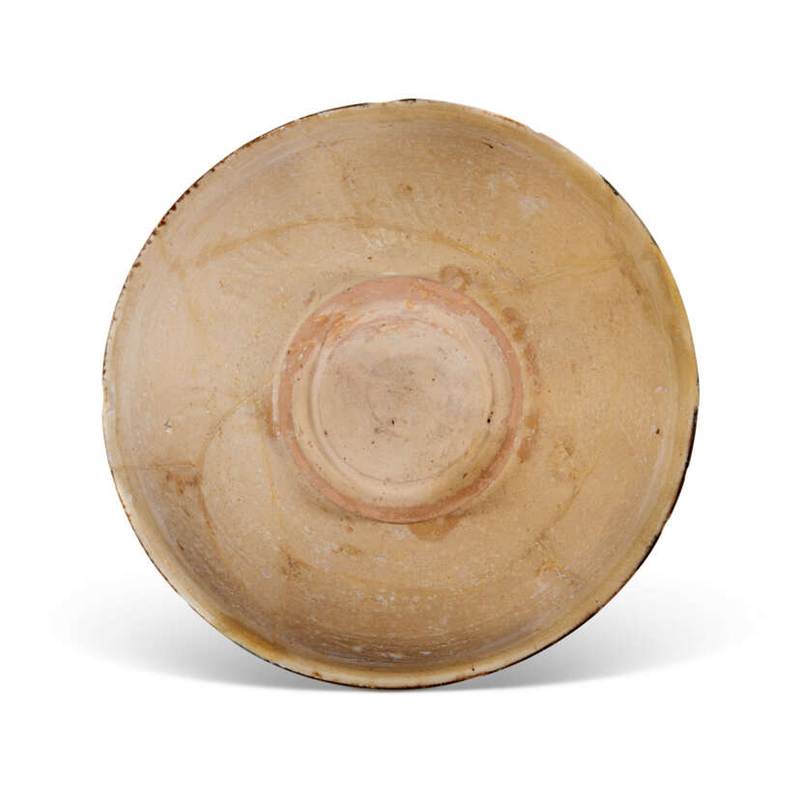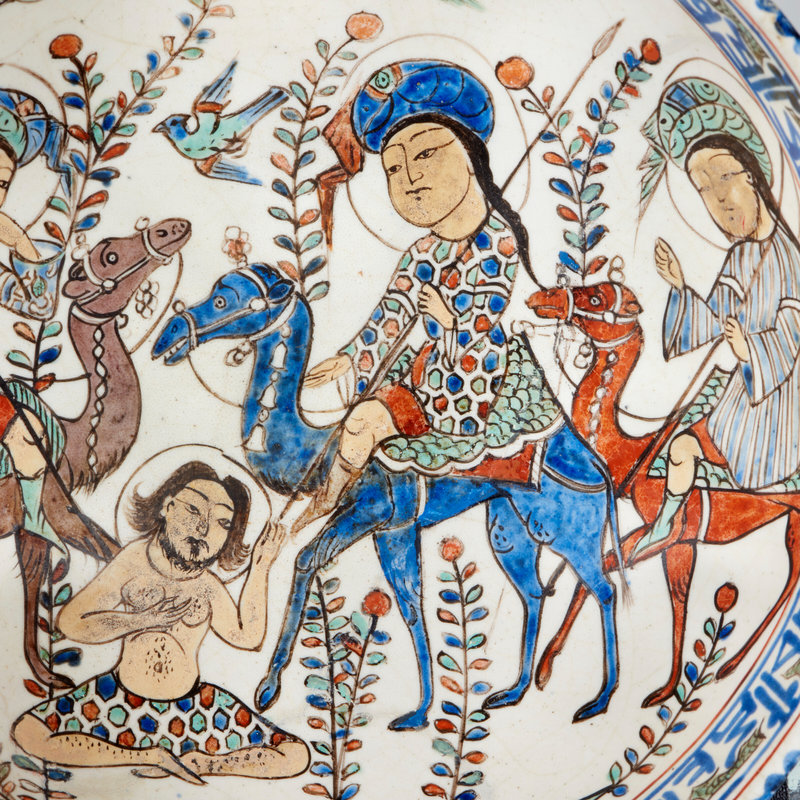Islamic Ceramics sold at Christie's London, 27.04.2023
Lot 8. A Samanid pottery bowl, Central Asia or North East Iran, 9th-10th century; 20.7cm diam. Price realised GBP 15,120 (Estimate GBP 12,000 – GBP 18,000). © Christie's Images Ltd 2023
The white interior with a band of dark brown floriated kufic in the cavetto, bands of geometric decoration towards around the rim, repaired breaks.
Provenance: With Nakashiba Shoji co. ltd., Tokyo, Japan, since early 1970s,
With Gallery N. Osaka, Japan, by 1981
Note: NSCRIPTIONS: Repeated, aateg 'be pious'
Samanid potters can be credited with the invention and perfection of slip-painted pottery – in which the clarity of design was achieved by painting brownish pigment mixed with slip on a white engobe painted over the red earthenware. In his discussion on Samanid poetry Ernst Grube writes that epigraphic pieces, such as the present lot, have beauty in their simplicity and an energy often lacking in the ceramics of later centuries. He goes on to write that ‘perhaps in no other form of early Islamic art … has the beauty of Arabic writing been made use of so successfully’ (Islamic Pottery in the Eigth to the Fifteenth Century in the Keir Collection, London, 1976, p. 94).
The band of inscription on our bowl is the same as one on a jug in the al-Sabah Collection (LNS 1087 C; published Oliver Watson, Ceramics from Islamic Lands, London, 2004, Cat. Ga.14.5, p. 216). The jug, which was sold in these Rooms, 16 October 2001, lot 230, is also decorated with a band of strapwork below the inscription of the type on the inside of the inscription band of our bowl. The style of the inscription on our bowl and the al-Sabah jug links to a group of elegant dishes, one of which is in the Khalili Collection (Ernst Grube, Cobalt and Lustre, London, 1992, no. 68, p. 79). The entry under that example notes two further related pieces published by Bol'shakov ("Arabskie nadpisi na polivnoi keramike Srednei Asii", Epigrafika Vostoka, 13, 1958, pp.32-58). A further dish from the group was offered in these Rooms 1 May 2001, lot 275.
Lot 13. A rare mina'i pottery bowl, Central Iran, circa 1200; 14cm diam. Price realised GBP 138,600 (Estimate GBP 30,000 – GBP 50,000). © Christie's Images Ltd 2023
Of round form on a short foot, the white ground painted in blue, green, orange, turquoise, red, beige and black with overglaze polychrome enamels, the interior depicting Layla and her two companions finding Majnun, an undeciphered kufic inscription around the rim, the exterior decorated with parrots alternated with palmette cartouches, repaired breaks.
Provenance: With K. Fujishiro, Japan, by 1967,
Acquired by Japanese trade until 2015, when purchased by the present owner.
Literature: K. Fujishiro, Islamic Pottery and Roman Glass, Japan, 1967, pl. 1.
Note: INSCRIPTIONS: On the inside of the rim: al-'izz al-da'im... 'Perpetual glory...'
The remainder is undeciphered.
This fine mina’i bowl boasts a delicately-painted design that perfectly suits the romantic theme of its decoration. The scene depicted on it portrays the touching moment when Layla's father has come to remonstrate with Majnun in the wilderness, where he had sought refuge following the rejection of his marriage proposal. Majnun is depicted sitting on the ground, his chest bare, symbolizing the ascetic life he has been leading. Accompanied by two companions, Layla’s father sits atop his camel in a regal coat, but his expression reveals the emotion of the encounter.
Mina'i production, like lustre painting, was expensive and labour-intensive because of the double or sometimes triple-firing process involved. The painterly quality of this bowl is what sets it apart and underscores the close connection between mina’i ornamentation and the painting traditions of its time. A comparison can be made with the illustrations found in the Varqa wa Gulshah, a manuscript possibly authored in Konya around 1250 AD and painted by ‘Abd al-Mu’min al-Khuwayyi, which is currently held at the Topkapi Saray Museum (Hazine 841). The figures and plants depicted in these illustrations is stylistically similar to those on this bowl, particularly in the way the tall leafy fronds and sinuous figures are portrayed. This bowl is a true showcase of mina’i craftsmanship and artistry, with the vibrant enamel colours emphasizing the exceptional quality of the painting.
Narrative mina’i bowls such as this example are rare. A similar finely painted mina’i bowl depicting a mounted horseman was sold at Sotheby’s London, 3 October, 2012, lot 173.
A thermoluminescence analysis of samples taken from the base of the bowl indicates a firing date of 790 years ago +/- 60 years.


Lot 30. A cuerda seca pottery tile, Safavid Iran, second half 17th century; 23.3cm square. Price realised GBP 11,970 (Estimate GBP 4,000 – GBP 6,000). © Christie's Images Ltd 2023
The square tile decorated with a blue border containing white flowers connected by cusped vines, a flying bird in the bottom left, repaired break.
Note: This tile comes from a large figural composition of the type which became popular during the reign of Shah Abbas I (r.1588-1629). An example of a complete frieze in the Metropolitan Museum of Art, New York (03.9c) is known to have been displayed in a garden pavilion built for the Shah in his new capital in Isfahan. The architectural setting for which this was intended is evoked by the way in which the border is stepped, probably to accommodate a window or roof-beam. Though they continued to be made into the Zand and Qajar period, the fine drawing, colour palette, and ornithological imagery is reminiscent of two white-ground tiles in the Louvre, Paris, which are dated to the second half of the seventeenth century. A further example of a Safavid cuerda seca tile of this type was sold in these Rooms, 27 October 2022, lot 50. For a larger composition of Safavid cuerda seca tiles, see lot 34.
Christie's. ART OF THE ISLAMIC AND INDIAN WORLDS INCLUDING ORIENTAL RUGS AND CARPETS, London, 27.04.2023

/https%3A%2F%2Fprofilepics.canalblog.com%2Fprofilepics%2F1%2F0%2F100183.jpg)
/https%3A%2F%2Fstorage.canalblog.com%2F03%2F02%2F119589%2F96711876_o.jpg)
/https%3A%2F%2Fstorage.canalblog.com%2F11%2F31%2F119589%2F94773502_o.jpg)
/https%3A%2F%2Fstorage.canalblog.com%2F20%2F83%2F119589%2F94772815_o.jpg)
/https%3A%2F%2Fstorage.canalblog.com%2F26%2F72%2F119589%2F75604929_o.jpg)
/https%3A%2F%2Fstorage.canalblog.com%2F59%2F60%2F119589%2F26458628_o.jpg)









/http%3A%2F%2Fstorage.canalblog.com%2F02%2F31%2F119589%2F129781552_o.jpg)
/http%3A%2F%2Fstorage.canalblog.com%2F74%2F07%2F119589%2F128676045_o.png)
/http%3A%2F%2Fstorage.canalblog.com%2F40%2F05%2F119589%2F127906166_o.jpg)
/http%3A%2F%2Fstorage.canalblog.com%2F90%2F51%2F119589%2F127906087_o.jpg)